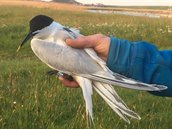In the spotlight: the Sandwich tern
The previous newsletter described our work on the Sandwich tern. This is a fascinating bird that breeds in the Dutch coastal zone and it is well worth a closer look.
Sandwich terns are food specialists, especially during the breeding season, when they feed a mix of herring, sprat and sand eels to their chicks. Their breeding behaviour is also remarkable. They breed in just a few colonies, but in enormous numbers in a very small area. Five nests per square metre is no exception. The colony we study in De Putten near Camperduin is home to 3,500 pairs of Sandwich terns. All of these birds find their food exclusively at sea, flying distances of 25 to 30 kilometres (and sometimes even 60 kilometres) from the colony.

Photo 1: Sandwich tern (Blue H04) with GPS logger on its back just before release in De Putten (source: M. Platteeuw).
But a lot is changing in the North Sea. Sand mining, commercial fishing and wind farms may all affect the habitats of these birds, which forage over a large area in Dutch coastal waters. Human activity can also cut off the birds from their food supplies: they are known to avoid wind farms. One of the Wozep aims is to predict those effects but we lacked crucial parameters such as habitat use, breeding time and population dynamics.
To estimate those parameters better and establish a clearer picture of the potential effects, Wozep asked Bureau Waardenburg to tag and track Sandwich terns with GPS loggers. We decided to study the colony at De Putten because it is close to two existing wind farms (OWEZ: Offshore Windpark Egmond aan Zee and PAWP: Prinses Amaliawindpark) which are therefore in the potential foraging range of this colony. You can read the article about the study itself in the previous newsletter.